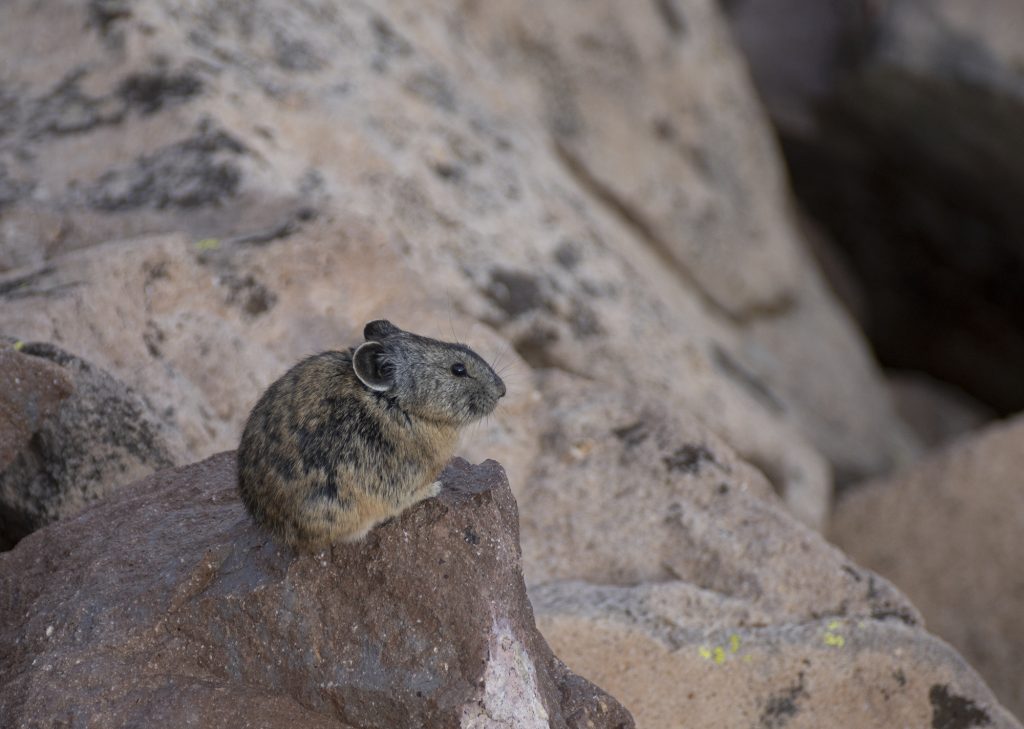CEDAR CITY — On a high-elevation trail surrounded by fields of volcanic rock something chirps, but it’s not a bird. A small rodent-like animal nimbly navigates across the rough terrain in search of food: a pika.

There are two species of pika in the United States: the collared pika, which is only found in Alaska, and the American Pika, found in the West, said Barbara Sugarman, who works as a Utah prairie dog recovery biologist at the Utah Division of Wildlife Resources.
“A lot of folks, especially not from the mountainous areas, really don’t know about pika, and … I think they are one of the coolest native species that we have here,” she said. “It’s really great to be able to view them and their personalities. They do have an attitude.”
While they appear similar to rodents, pikas are closely related to other lagomorphs, like rabbits and hares, Sugarman said. Instead of long, floppy ears, however, they have short mouse-like ears. She said the way they move is “rabbit-like but in a very hamster-like body.”
“And they’re just insanely agile,” she added. “They like hop – you see it when you watch them move on the landscape, but their ability to just go across the rocks and because they’re so lightweight, they don’t displace any of the rocks.”

Pikas live in high-elevation environments on talus, which is a mass of broken rocks, typically on a slope. In Southern Utah, many pikas live in networks under lava fields, like those found by Brian Head, Sugarman said.
Because they live in remote, rugged terrains that are difficult to access, they are not often the subject of human-wildlife conflict, Sugarman said.
“It’s kind of fun that it can be out there being cute and not really bothering anybody too much,” she said.
Pikas require a cool climate and can maintain their temperature by seeking shelter in the talus, out of direct sunlight, Sugarman said. In the Winter, they live under a blanket of snow, which holds in thermal heat.

Pikas collect vegetation into hay piles. Because they don’t hibernate, they store food to eat throughout the winter. The little mountain dwellers compete with each other for food and are known to steal from one another.
“And they defend these hay piles quite fiercely, and everybody collects their own – there’s no sharing,” she said.
Sugarman said pikas are “thoroughly individualized” and defend their territories, and that females will do so “as much as any male.” Pikas mate approximately 30 days after meeting and give birth to “fairly helpless” young. But, after about 40-50 days, the offspring are full-grown and establish their own territories.
“It’s not like prairie dogs where (pups) get a little bit more time and care and they have a lot more sense of social structure – a colony is really a group,” she said. “With pika, it’s just individuals on the landscape, honestly.”
Indicator species

Sugarman said that pikas tend to “drum up interest” because not only are they “insanely adorable,” but they are also considered an indicator species. As a high-elevation animal that is adapted to cold weather, pikas are sensitive to temperature changes and are prone to overheating.
Their presence or absence at a particular site can indicate environmental changes also affecting other species, Sugarman said.
The Utah Division of Wildlife Resources completes pika surveys depending on funding, which they receive through the Endangered Species Mitigation Fund, Sugarman said, adding that she worked as a field technician during the most recent pika survey in 2017.
She said the next survey is likely to take place in 2023, pending approval and various other factors. Technicians will record pika sightings, vocalizations and other evidence of their presence, such as fecal deposits or hay piles. These surveys are meant to detect changes over time. For instance, whether pikas were observed in a location during the previous survey but not the current one. Talus sites are surveyed by the division July-August, occasionally into September.
Viewing pika
Pika season is short, Sugarman said and suggested people take advantage of the chance to view them while they are active. Once winter arrives, they spend much of their time in their dens.

During monsoon season, the best time to observe pikas is in the morning, so viewers can head down the mountain before thunderstorms hit.
“Because you are quite exposed on talus, there is nowhere to go,” she said. “So it’s definitely not a place that you want to be during lightning striking.”
Those interested in pika viewing should check the weather ahead of time and remain watchful while outdoors.
“Conditions can change really quickly and it can get dangerous really quickly,” Sugarman added.
In an article shared by the Utah State University Extension office, observers are reminded not to climb the rocky slopes where pikas live to avoid disturbing their dens or getting injured.
The authors suggest people observe them quietly, as the small mammals can quickly disappear into the rocks. Additionally, for pika sightings at Cedar Breaks National Monument, they suggest filling out a rare-animal sighting form available at the visitor’s center or fee booth. For sightings elsewhere in Utah, email the DWR here.
Those interested in viewing pikas or other wildlife can search for recorded sightings on the iNaturalist app. The app was a joint venture by the California Academy of Sciences and the National Geographic Society to help users identify plants and animals and connect to scientists and naturalists to learn about nature, according to its website.
“By recording and sharing your observations, you’ll create research quality data for scientists working to better understand and protect nature,” the site states.
Photo Gallery
Copyright St. George News, SaintGeorgeUtah.com LLC, 2022, all rights reserved.







